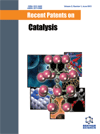Recent Patents on Catalysis (Discontinued) - Volume 2, Issue 1, 2013
Volume 2, Issue 1, 2013
-
-
Heterogeneous Catalysis by Gold-based Bimetallic Catalysts
More LessAuthors: Like Ouyang, Guo-Jin Da, Jun Ni, Jing Xu and Yi-Fan HanThis critical review summarizes recent advances on the preparation, characterization and application of Aubased bimetallic Au-M catalysts. Particularly bimetallic Au-Pd, Au-Pt and Au-Ag catalysts have been emphasized. The diversity of the structure and combination of these bimetallic Au-M catalysts leads to various catalytic performances in, i.e., oxidation, hydrogenation, electrocatalytic, and photocatalytic reactions. The promotional effects of Au have been discussed by its electronic and geometric modifications of active metals. Efforts on controlling the structure (morphology, particle size and growth of crystalline) of supported bimetallic Au-M catalysts via advanced synthetic approaches have been elaborated. An overview on the challenges and opportunities for future research toward the understanding of catalytic chemistry of gold-based bimetallic systems has also been presented along with the descrption of few of the recent patents.
-
-
-
Cinchona Alkaloid-Catalyzed Stereoselective Carbon-Carbon Bond Forming Reactions
More LessAuthors: Srinivasarao A. Babu, Ramasamy V. Anand and Sripada S.V. RamasastryThis review provides insights into the patents available on one of the subfields of organocatalytic reactions, specifically, the Cinchona alkaloids-based organocatalytic reactions, involving asymmetric C-C bond construction. Some of the very important achievements in the asymmetric carbon-carbon bond formation by employing the Cinchona alkaloids- based organocatalysts, one of the privileged classes of asymmetric catalysts, have been accentuated. The Cinchona alkaloids-based enantio- and diastereoselective syntheses of a range of amino acid derivatives, bioactive molecules and various synthetic intermediates with high efficiency are also highlighted.
-
-
-
Dimethyl Ether Synthesis Catalysts, Processes and Reactors
More LessAuthors: Grigore Bozga, Ioan T. Apan and Raluca E. BozgaThe paper is reviewing the patents and journal papers treating catalysis and engineering issues involved in the dimethyl ether (DME) production from synthesis gas. The necessary catalysts include components active for the two reactions defining this process: carbon oxides hydrogenation to methanol and methanol etherification to DME respectively. For the first reaction, amongst the dozens of catalytic materials proposed, the largest utilization has the classical methanol synthesis catalyst Cu-ZnO-Al2O3, sometimes modified with ingredients contributing to the increase of the copper dispersion and stability. Good activity and selectivity for methanol etherification have the solid acids with moderate acidity (γ- Al2O3, zeolites, mesoporous materials etc.). An important challenge in the formulation of the bi-functional catalyst and the reactor design is the prevention or limitation of deactivating phenomena: copper sintering, coking of acidic components and metal ions migration. Particularly, a good temperature control is necessary, due to the important overall process exothermicity. Demonstration plants having capacities up to 100 t DME/day, based on tri-phase slurry reactors or jacketed multi-tubular reactors, are already in successful operation. An important drawback of the one-step DME synthesis process is the formation of CO2 as secondary product, difficult to separate from DME mixture. Patented technologies are based on separation by extraction with selective solvents or by refrigeration and distillation. Efficient and environmentally friendly design solutions are integrating the DME synthesis line with hydrocarbon reforming units, recycling and valorizing CO2 byproduct. Studies are also in progress, aiming to develop technologies for DME synthesis by CO2 hydrogenation.
-
-
-
Ru-exchanged Supported 12-tungstophosphoric Acid for Selective Liquid Phase Aerobic Oxidation of Styrene under Solvent-free Conditions
More LessBy Anjali PatelRu3+-exchanged supported 12-tungstophosphoric acid was synthesized, characterized and used for solvent-free liquid phase aerobic oxidation of styrene under mild reaction conditions. The present catalyst gives 100 % conversion of styrene with >99 % selectivity for benzaldehyde. The catalyst can also be regenerated and reused.
-
Volumes & issues
Most Read This Month


